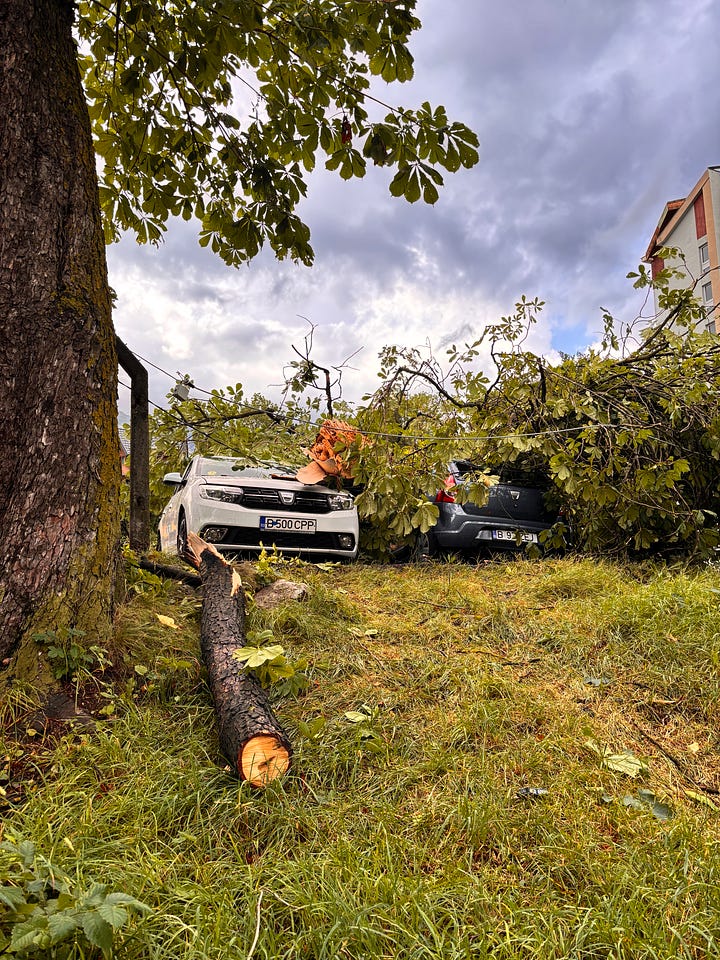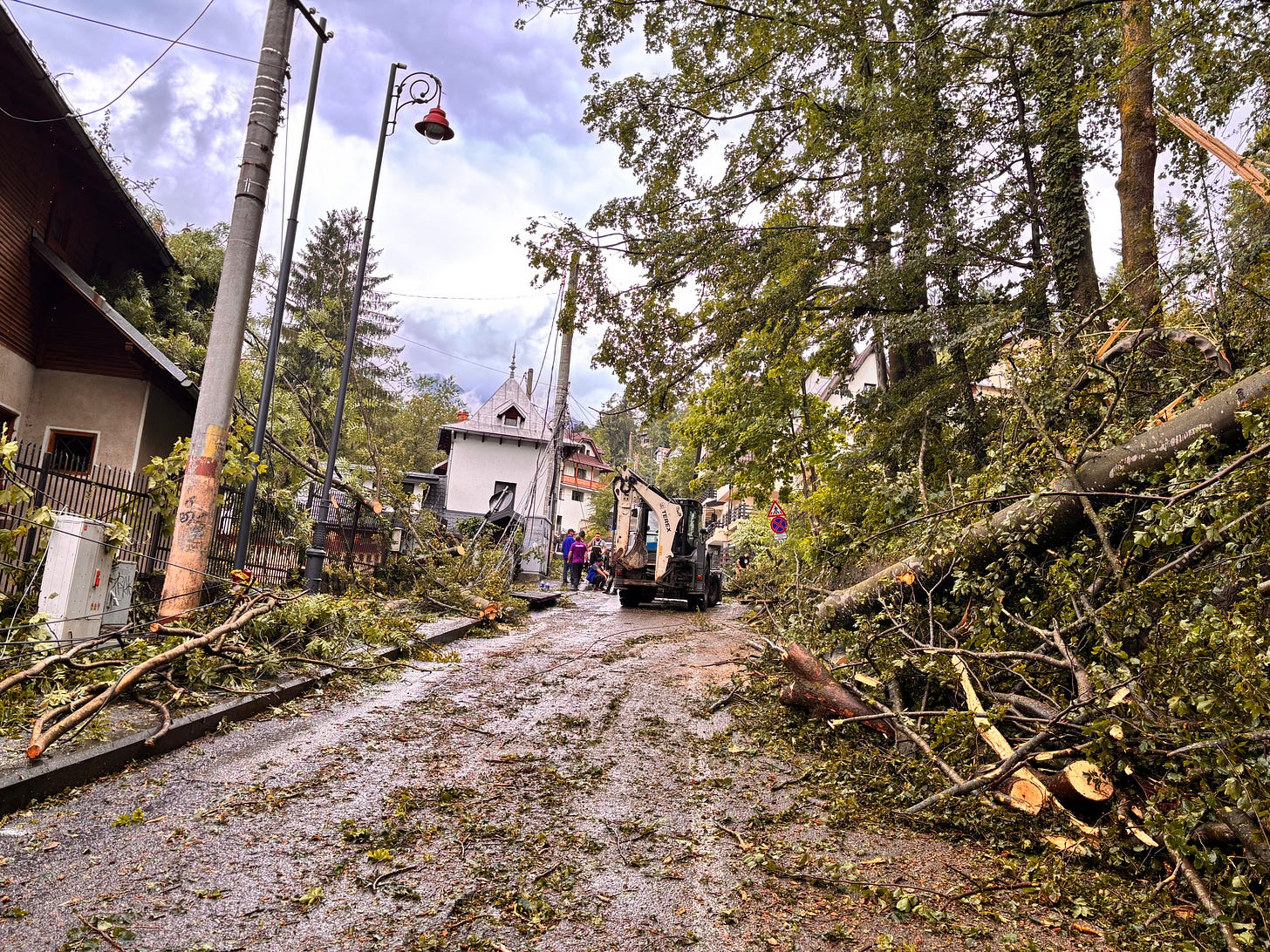Surviving the unexpected
What a ten minutes storm in the Carpathians tells us about the future of climate




‘My son took cover under a car. Then a tree fell right in front of him. He saw death with his own eyes,’ says the waitress, serving the Turkish coffee.
The morning after the storm seems eerily peaceful, like the dreamy, beautiful face of the woman contemplating the possibility of an unfathomable loss.
‘I watch those natural disasters in the USA, like hurricanes, on TV and think to myself: This cannot be. It must be staged. You don’t believe it until it happens to you.’
🜃
It’s melting hot in the Sinaia resort tucked in the Carpathian Mountains. We’re walking on the winding asphalt road carved into the mountain slope when my husband’s phone buzzes with an alert: a hailstorm with 80km/h winds is approaching fast. We hurry back to the villa where we’re staying for the next four nights and reach our room just before the sky turns dark.
The first hailstones hit the wooden planks of the little balcony, and a mighty wind sweeps through the tall pines, bending them in all directions as if they were made of rubber. The temperature drops at once, and for the next ten minutes, a mother-of-a-storm torments the scenic valley surrounded by majestic mountains. From our cozy balcony, we watch, hypnotized, nature’s furry unleashing upon us—terrible but beautiful, like a scornful queen from a fairytale.
The storm ends as abruptly as it started. Before long, the sun shines again in the blue sky. Our electricity is out, and there’s no internet. The blaring sound of sirens pierces the quiet afternoon. At first, we don’t make much of it, especially because the electricity comes back shortly afterwards. But after about two hours, our phones still have zero coverage, and my husband needs to do some work for the next day. We decide to go down to the centre to look for an internet café.
Rivulets of water rush down the asphalt road. We descend a steep flight of stairs that cuts to the center and are astonished to find the stone-paved road at the bottom covered in mud and broken branches. Luckily, I’m wearing my hiking boots. We take a sharp right turn into a side street lined on one side by villas and on the other by a narrow, steep tree line—and stop in our tracks. Entire trees lie across the street, tangled in electricity wires. The street is covered in a flurry of green leaves and broken branches.
We walk past workers cutting up the trees felled by the storm and a cherry picker where two men look up at a third colleague battling a loose tangle of electricity wires. At the end of the street, we see two giant trees completely uprooted. One rests on the crushed rooftop of a villa. We can see the interior of the attic. It’s a guest room. We wonder aloud if the guests made it out alive.
The city center is an apocalyptic site: trees fallen on top of smashed cars in hotel parking lots, blown off metal rooftops piled on sidewalks, broken signs and the worst of all, the city park which looks like a battlefield strewn with fallen soldiers. We hear that the wind tore away the metal rooftop of the royal train station.
I find it hard to believe that so much destruction is possible in less than ten minutes.
🜃
Once upon a time the summer residence of the royal family, Sinaia is today a prime summer destination for those trying to escape the sweltering hot capital of Bucharest, located only a couple of hours away. Nestled in the Prahova River valley at the foot of the Carpathians, Sinaia is normally sheltered by the surrounding mountains and forests from winds and storms. The unexpected apocalyptic storm comes as a shock to the area’s inhabitants. At the internet café, we’re told that customers over seventy years old can’t remember ever experiencing anything like this before. They had to hold the door of the café so that the winds don’t blow it away.
The previous summer, I’d visited the nearby city of Brasov—the former Kronstadt (Crown City), built at the heart of the Carpathians—during the record heatwaves that swept the European continent. The locals told me the same thing: It’s never been this hot before.
I can’t help but think of the climate change research I did for There Is Hope, a cli-fi novel I recently finished serializing here on Substack. I had hoped that Romania, my birth country, will be more sheltered from climate change thanks to its mountains, large pristine forests, diverse ecosystems, and relatively abundant clean water. Unfortunately, my research showed the opposite. Sadly, the European continent is heating up faster the rest of the world, and Central Europe is projected to turn into a Dust Bowl as temperatures rise. Romania will be among the countries hit hardest by climate change because it’s landlocked.
These past two summers I’ve been astonished at the heat I experienced in the heart of the cool Carpathian Mountains. One of the main issues climate change is that the worst damage occurs in short episodes of unpredictable weather, like the never-before-seen storm from Sinaia or the record heatwaves from last summer. Unfortunately, such climate events will occur more frequently in the future.
How many times can communities rebuild after such episodes?
How can they adapt to rising temperatures?
🜃
The next day, we still don’t have internet in our room. We hear that in the city centre the mayor had a project to move the electricity cables underground to make the streets look prettier, which means that infrastructure there was less damaged. We go to a hotel in the city centre to rent a room with functional internet for my husband‘s work calls. Some hotel guests are gathered at the reception, loudly demanding that the hotel clean up the parking lot of fallen trees so that they can drive away, or complaining that there’s still no TV service in their rooms. It seems people have little patience for nature’s interruption of their vacation plans.
In the nearby park, we observe the locals going about their lives: a mother and a daughter eating pancakes on a bench surrounded by piles of tree branches; elderly people soaking in the sun around the water fountain, while city workers buck tree trunks and piling broken branches into pick up trucks. It will take a while for it all to sink into the hearts of the local community and even longer to repair the damage. I hope that the wealthy owners of vacation villas and tourist businesses who rely on the local infrastructure will see it in their heart to help restore the area.
‘There’s no doubt that this is man-made weather. All the trees they’ve been cutting in the area, the money chase, and ceaseless the human activities contributed to this,’ a local says.
🜃
There Is Hope is a collection of future human memories saved in a database called The Museum of Life. I would like to submit this article as a future artefact in that museum—a memory from the summer of 2025 that will give future generations a glimpse into life in the first half of the twenty-first century, when we still had the chance to change the future.
Will we do it?
🜃
🌿 If you’d like more stories from the crossroads of fiction and reality, and reflections on how our world is changing, consider subscribing or upgrading to a paid subscription to my newsletter. Let’s keep exploring the future—and how we might still shape it—together.



Two days after the storm, I’m sitting in an Indian restaurant waiting for my chana masala. The city center is cleaned out and life goes on. But in the most hit area the houses still don’t have any electricity, our internet is still out and there’s no TV service.
Over here, the Grand Canyon Lodge just burned down in a wildfire.